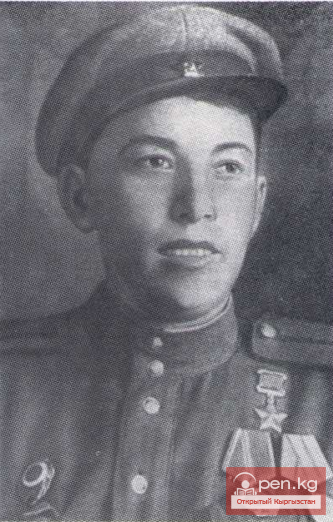
Hero of the Soviet Union Taranchiev Ismailbek
Pilot of the 566th Assault Aviation Regiment of the 277th Assault Aviation Division of the 13th Air Army of the Leningrad Front, Junior Lieutenant.
Born on April 6, 1923, in the village of Bashkungey, now in the Bishkek region of Kyrgyzstan, in a peasant family. Kyrgyz.
Graduated from 8 grades.
In the Red Army since June 1941. In 1943, he graduated from the 3rd Chkalov Military Aviation School of Pilots. Participated in the battles of the Great Patriotic War since January 1944. Member of the VKP(b)/CPSU since 1944.
Pilot of the 566th Assault Aviation Regiment (277th Assault Aviation Division, 13th Air Army, Leningrad Front), Junior Lieutenant Ismailbek Taranchiev, by March 18, 1944, had completed thirty-five successful combat sorties on the Il-2 aircraft to attack defensive structures, equipment, personnel, railroads, airfields, and other enemy targets.
On February 26, 1944, as part of a group during the attack on the airfield in the Estonian city of Tartu, Taranchiev personally set fire to three enemy aircraft.
On March 18, 1944, as part of a group of four aircraft, performing a combat mission from the command to attack enemy troops and equipment in the area of Yaama-küla, Kyäriküla, Lastikolonii (Finland), Junior Lieutenant Ismailbek Taranchiev directed his flaming winged machine, hit by enemy anti-aircraft artillery, into a cluster of enemy tanks.

The feat was accomplished during fierce battles on the Narva Isthmus - the only road from the liberated city of Leningrad to Tallinn, which was strategically important for the Red Army's advance to the West. In 1943, near Narva, the Germans built deeply echeloned two lines of defense "Panther" and "Tannenberg".
The key point of "Tannenberg" was the powerful concrete fortifications on the heights near the village of Sinimäe. The battles for these heights, which controlled the narrow passage between the Gulf of Finland and the impenetrable swamps, claimed tens of thousands of our soldiers' lives. The destruction of these fortifications on the Sinimäe heights (defended by Germans, Dutch, Flemish, Danes, and Estonians to the last soldier) could mainly be achieved with heavy bombs using assault aviation.
Heading for the mission on March 18, crew commander Ismailbek Taranchiev understood the complexity of the situation.
With their feat, the crew contributed to the destruction of the main German defensive line on the Narva direction, where the advance of the Red Army had been halted for a long 7 months.
The glorious son of the Kyrgyz people was nominated for the title of Hero of the Soviet Union in March 1944.
By the decree of the President of the USSR dated May 5, 1991, for courage and heroism displayed in the struggle against the German-fascist invaders during the Great Patriotic War of 1941-1945, Junior Lieutenant Taranchiev Ismailbek was posthumously awarded the title of Hero of the Soviet Union. The Hero's relatives were awarded the Order of Lenin and the medal "Gold Star" (No. 11648).

Awarded the Order of Lenin, Orders of the Patriotic War 1st class, Red Star, and a medal.
In Estonia, in the Vaivara parish, a memorial sign has been installed at the site where Il-2 I. Taranchiev fell.
A street in the village of Besh-Kunghey in Kyrgyzstan is named after I. Taranchiev.
In 2015, for the 70th anniversary of Victory, the postal service of the Republic of Kyrgyzstan issued a postage stamp dedicated to Ismailbek Taranchiev.
Since December 2017, the Su-25 attack aircraft of the Russian military airbase Kant in Kyrgyzstan has been named after Ismailbek Taranchiev.











































